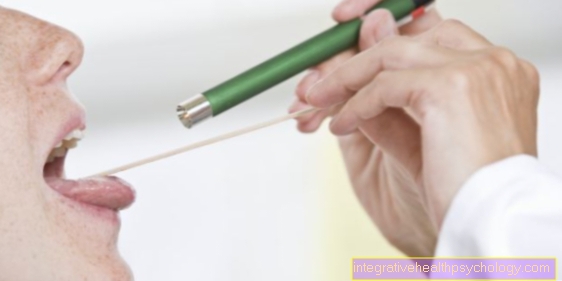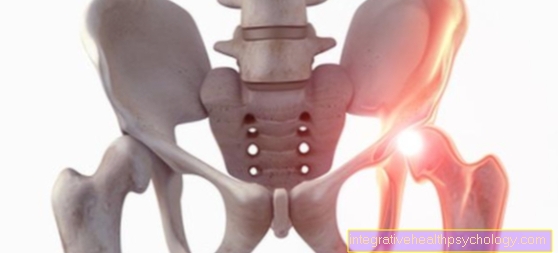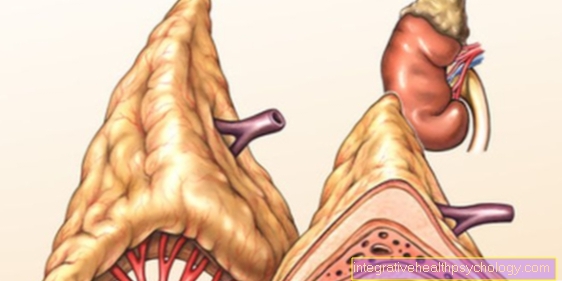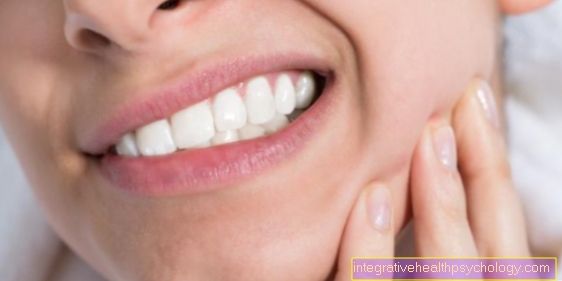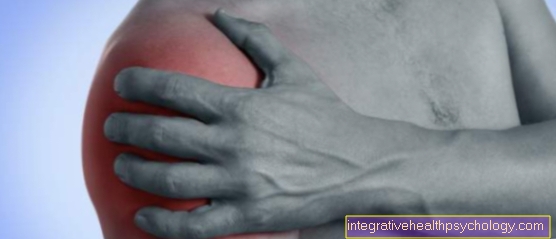Birthmark itches
Synonyms in a broader sense
Mole, nevus
introduction
A birthmark is a special form of the mole, i.e. a benign growth of pigment-forming skin cells in most cases. In medical terminology, the synonyms are Pigment nevus or Nevus common. The term “birthmark” is chosen rather superficially and does not provide any information about the type of cells that have overgrown. In general, a birthmark can arise from red blood vessel cells, yellow sebum cells, or other cells.
This also explains the fact why birthmarks can have different colors. Some birthmarks are visible after birth, but the number of these skin changes increases over the course of life in most people. Most birthmarks are completely harmless phenomena with no malignant character. Nevertheless, with some of these skin spots there is a risk of degeneration and thus the development of malignant forms of cancer (malignant melanoma).
An itchy mole is a symptom of increasing severity that should definitely be clarified by a doctor, as it can be an indication of the degeneration of the mole.

In particular, birthmarks that change over time should be presented to a specialist. If a birthmark changes his
- Color or shape
- becomes larger or uneven
any degeneration must be excluded. In addition, a mole that itches or bleeds should be urgently examined. A bleeding birthmark does not have to be an indication of malignancy in every case. The sometimes intense itching often causes the affected patient to start scratching the birthmark. In this case, bleeding is not a separate warning sign. Other signs of malignant melanoma are
- Pain (please refer: Painful birthmark)
- Sting
- Burn
in the area of skin changes.
The itching in the context of a visible skin change is called "Pruritus cum materia" designated.
Causes of itchy birthmarks and their potential dangers
If a patient notices a birthmark that itches, it must be examined for degeneration. The itching in the area of this type of skin lesion is in many cases a serious warning sign. A common cause of a birthmark that itches is the presence of a so-called malignant melanoma (black skin cancer).
Malignant melanoma can be removed quickly and easily, but due to the high rate of metastasis it is a serious disease. Black skin cancer tends to spread primarily via the lymphatic and bloodstream and infiltrate other organs. Malignant melanoma is the most common fatal skin disease.
A sharp increase in the number of black skin cancer cases can be observed worldwide. This fact can be explained by the increased sun exposure that many people expose themselves to. The use of sunbeds in particular is a serious problem these days. Other risk factors for the development of such a melanoma are:
- already experienced malignant forms of cancer
- severely weakened immune system
- family history and
- Disturbances in the DNA repair system
In addition, it can be determined that especially fair-skinned people with blonde hair and blue eyes are more likely to develop black skin cancer that itches. Although it is much more common that a dark birthmark that itches is based on a malignant skin change, so-called white skin cancer can also lead to severe itching.
In contrast to malignant melanoma, white skin cancer can take a wide variety of forms. Often it already shows up as
- Early form (actinic keratosis)
- Basal cell tumor (basalioma) or
- Squamous cell carcinoma (squamous cell cancer, spinalioma)
Due to the strong hormonal changes in the course of pregnancy, an increased formation of new birthmarks can also be observed in expectant mothers.
Diagnosis of a birthmark that itches

A mole that itches can be checked for malignancy by the affected patient at home. The application of the so-called "A-B-C-D-E rule" helps to get an initial assessment of the cause of the itching on the birthmark. Each of the letters in this rule stands for one Property of the skin spot which should be judged.
- A = asymmetry (Is the shape of the birthmark uneven or is it a round / oval mark?)
- B = limitation (Is the border irregularly limited / frayed or jagged?)
- C = coloring (Has the color of the birthmark changed over time?)
- D = diameter (Does the diameter of the birthmark increase over time? Is the diameter of the birthmark more than 6mm?)
- E = sublimity / development (Has the birthmark changed? Is there bleeding? Does the birthmark itch? Does the birthmark stick out from the surrounding skin level?)
The more of these key points apply, the more important it is to get the relevant birthmark promptly from a specialistt (Dermatologist) appraise allow. A doctor can identify the early stages of a degenerate birthmark that itches. In particular, the use of a so-called reflected light microscope has established itself in everyday clinical practice.
From the age of 35, any noticeable skin changes should every two years through this procedure examined for degeneration become. Usually, a suspicious mole that itches will removed as soon as possible and to more precise diagnostics in a special laboratory sent in.
Aching birthmark
Usually prepare Birthmarks no problems: you are painless, unattractive and besides a dark discoloration with no noticeable sign. All birthmarks and Moles it is usually mean that you do not feel it at first. A sudden onset of itching is - if it is not due to the condition of the skin in general (for example due to very dry, flaky skin or as a sign of a Neurodermatitis) - as well as pain a reason to have the birthmark examined by a dermatologist.
Of course, itching does not always mean that a diagnosis of a malignant tumor will follow, but it does Pain are as references to a possible degeneration to interpret the affected skin area and take it seriously. As a rule, severe pain indicates an already advanced stage of the malignancy, so of malice, one Tumor on. This should then be confirmed or excluded as quickly as possible.
So if the birthmark itches and hurts, an appointment is with you Dermatologist necessarily indicated.
Birthmark on the child
In children it is of particular importance to differentiate precisely whether the whole skin itches and / or hurts or just that birthmark is directly irritated. This distinction is not always easy to make. The localization of the pain often remains vague, especially with smaller children who are not yet able to express themselves precisely enough. In principle, friction can also be an impetus for the child to scratch. You should therefore observe the child's behavior and the situations in which itching occurs as closely as possible.
The child (like adults of course) should try, if possible, not to scratchto avoid further irritation. A dermatologist can then decide whether there is a skin disease that needs to be treated in each individual case or whether there is even a suspicion of a tumor. The latter, however, is extreme in children Rare. Most degenerate skin changes only appear with increasing age.
More common cause of itchy spots in children are Eczema or one allergic reactions of the skinthat was previously unknown. Against the acute itching it helps to keep the child with as much as possible Skin pH neutral soaps to wash and moisturizing body lotions to use with as few artificial ingredients as possible, as children's skin is still particularly sensitive and all kinds of additives are used as Contact allergens can be considered.
The birthmark in pregnancy

Each pregnancy goes with great hormonal Changes in the body of the expectant mother are associated.
In the course of these changes, there may be an increased formation of Birthmarks come.
In the first place, this is neither dangerous nor worrying; they are normal, acquired birthmarks.
To yourself below before using Skin cancer To protect associated malignant preliminary stages and the like, the newly created birthmarks as well as others that have been present for a long time should be protected from direct sunlight and should not go to the solarium.
However, during pregnancy, more benign moles on average change to malignant precancerous stages or types.
Pregnant women should therefore pay attention to their moles and watch out for signs like itching, Shape change or Pain consult a dermatologist without delay.
When the birthmark grows
Changes in size You should always keep a close eye on a birthmark. Last but not least, the most effective methods of the are based on growth or changes in shape Skin cancer screenings. So if a birthmark itches and grows (or even just changed its size), there is again suspicion of one malignant degeneration of the affected birthmark.
However, birthmarks (as described above) can also arise or grow for other reasons. A certain influence of various factors is certain Hormones and a genetic component. People with particularly fair skin tend to be more familiar, many Birthmarks and Moles so that they should pay particular attention to themselves and the areas of the skin.
In addition, a direct cause does not have to be identifiable in every case. One speaks of idiopathic Done when there is a change or disease developing no direct trigger to arrange. Even if all in all a malignant tumor is rarely behind the growth and changes in a birthmark, a certain risk should not be taken lightly and regular checks at the dermatologist as well as conscientious Introspection make it your own routine.
Therapy / what to do

A mole that itches is removed as soon as possible in most cases. In the surgical removal of the birthmark the skin changes should be cut out as a whole with a sufficiently large safety margin to healthy skin. Depending on the thickness and diameter of the skin change, the necessary safety distance is between one and two centimeters.
In addition, care must be taken with the affected skin area all skin layers except for the muscle fascia be completely removed. Should a birthmark that itches im Area of the face occur, a surgical removal with the help of a microscope can be carried out to reduce the subsequent scar size (microscopically controlled surgery).
A birthmark that itches is usually removed under local anesthesia, i.e. after a local anesthetic has been injected into the skin. A biopsy is not taken before the actual birthmark is removed, as otherwise there is a risk of spreading into the Bloodstream and / or lymph fluid consists.
In order to check whether the mole that itches is a malignant melanoma, this is done forwarded to a special laboratory after successful surgical removal and examined there microscopically. If the birthmark in question has been identified as malignant in the laboratory, a Examination of the nearest lymph nodes be useful.
There is also the possibility of a suspicious mole under Using a laser to remove it. However, this method is rarely used in everyday clinical practice. Despite less noticeable scarring, the Laser application not preferable to surgical removalbecause the tissue is burned in such a way that a Examination for malignancy no longer possible is.
Patients who have a mole that itches should never try to remove the skin change yourself. On the one hand, improper removal of a mole can lead to Development of unsightly scars to lead. On the other hand, you can life-threatening infections be the consequence.
- Removal of a birthmark
- Lasering a birthmark
forecast
Not every mole that itches has to have malignant cancer cells. Noticeable skin changes can also be completely harmless in nature. A birthmark that itches after the Removal of degenerate cells found have a different prognosis. Important factors in the assessment are the
- Tumor thickness
- Penetration depth and
- Subtype
the abnormal cells.
In addition, the time at which the birthmark was removed also plays a crucial role. With early diagnosis and swift surgical removal of the melanoma, the prognosis is very good. The chances of one complete healing is good. Especially those moles that contain altered cells that reach into the deep layers of the skin tend to form metastases. Malignant melanoma can metastasize to different organs. The most commonly affected are those
- liver
- lung
- Skeletont and
- Brain.
Viciously changed birthmarks that itch, but just as often spread to other skin areas. After capturing a malignant birthmarks should therefore be checked urgently whether a dispersion has already taken place. Patients who metastasized in the Lungs and / or the brain have, have a very bad prognosis.
prophylaxis

The formation of an ordinary birthmark can hardly, if at all, be prevented. Those moles that show malignant cell changes can be prevented by following a few rules of conduct. Since the Main cause of malignant melanoma above-average sun exposure is can through the Avoidance of the midday sun in summer the risk of developing skin cancer can be significantly reduced.
In addition, regular, careful use of one helps Suntan lotion while keeping the UV radiation away from the skin. Children in particular should not be sent out into the sun without clothes. We also recommend wearing a T-shirt on the beach.

